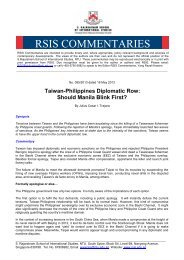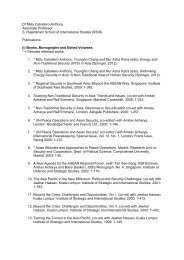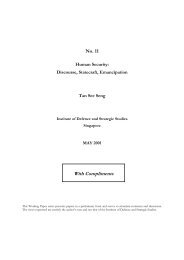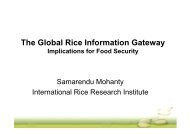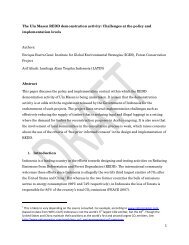Armada Jaya XXX/11 - S. Rajaratnam School of International Studies
Armada Jaya XXX/11 - S. Rajaratnam School of International Studies
Armada Jaya XXX/11 - S. Rajaratnam School of International Studies
You also want an ePaper? Increase the reach of your titles
YUMPU automatically turns print PDFs into web optimized ePapers that Google loves.
__________________________________________________________________________________________________<br />
Synopsis<br />
No. 176/20<strong>11</strong> dated 29 November 20<strong>11</strong><br />
“<strong>Armada</strong> <strong>Jaya</strong> <strong>XXX</strong>/<strong>11</strong>” Naval Exercise:<br />
Indonesia’s Naval Strategy<br />
By Ristian Atriandi Supriyanto<br />
Indonesia recently concluded a naval exercise close to disputed waters. This serves as a hint <strong>of</strong> Indonesia’s<br />
future naval contingency planning and broader military strategy.<br />
Commentary<br />
THE INDONESIAN Navy (TNI-AL) has just concluded a naval exercise codenamed “<strong>Armada</strong> <strong>Jaya</strong> <strong>XXX</strong>-<strong>11</strong>” (AJ<br />
<strong>XXX</strong>/<strong>11</strong>) in waters <strong>of</strong>f Sangatta, East Kalimantan, roughly 330 nautical miles (nm) south <strong>of</strong> the disputed<br />
Ambalat waters with Malaysia. The exercise, which started from 31 October to 18 November 20<strong>11</strong>, involved<br />
over 4000 naval personnel, including 2500 marines; 23 vessels, <strong>11</strong> aircraft, and 93 military vehicles.<br />
The exercise was intended to enhance the TNI-AL’s sea control and amphibious capabilities, which have<br />
recently been upgraded with new platforms and weapon systems. Given the proximity <strong>of</strong> the exercise to<br />
disputed waters, and its location at the Makassar Strait used for international navigation, what does this tell us<br />
about the TNI-AL’s future contingency planning? And how does it fit into the broader Indonesian military (TNI)<br />
strategy?<br />
<strong>Armada</strong> <strong>Jaya</strong> <strong>XXX</strong>/<strong>11</strong><br />
RSIS COMMENTARIES<br />
RSIS Commentaries are intended to provide timely and, where appropriate, policy relevant background and analysis <strong>of</strong><br />
contemporary developments. The views <strong>of</strong> the authors are their own and do not represent the <strong>of</strong>ficial position <strong>of</strong> the<br />
S.<strong>Rajaratnam</strong> <strong>School</strong> <strong>of</strong> <strong>International</strong> <strong>Studies</strong>, NTU. These commentaries may be reproduced electronically or in print with<br />
prior permission from RSIS. Due recognition must be given to the author or authors and RSIS. Please email:<br />
RSISPublication@ntu.edu.sg or call (+65) 6790 6982 to speak to the Editor RSIS Commentaries, Yang Razali Kassim.<br />
AJ <strong>XXX</strong>/<strong>11</strong> began with a scenario that an enemy seaborne task force had infringed Ambalat waters and cut<br />
through the TNI’s Tarakan-Sangatta line <strong>of</strong> communications. In response, TNI-AL mobilised its assets to retake<br />
Ambalat and mounted an amphibious landing at Sangatta to round-up the enemy’s ground forces. TNI-AL also<br />
conducted sea control exercises en route to the area, such as anti-surface, anti-submarine, and anti-air warfare<br />
drills.<br />
This exercise correlates with the TNI-AL strategy <strong>of</strong> “Archipelagic Sea Defence Strategy” (Strategi Pertahanan<br />
Laut Nusantara, SPLN), which puts an emphasis on “strategic funnels” (corong strategis). Simply defined,<br />
“strategic funnels” refer to the bodies <strong>of</strong> water located at both ends <strong>of</strong> Indonesia’s three north-south archipelagic<br />
sea lanes (ASLs). The AJ <strong>XXX</strong>/<strong>11</strong> was conducted at the northern end <strong>of</strong> the second ASL, which runs from the<br />
Lombok Strait to Makassar Strait and ends in the Sulawesi Sea.<br />
The TNI-AL has perceived the strategic funnels as potential future flashpoints, considering its proximity to<br />
neighbouring countries, abundant marine resources, and unresolved maritime boundary disputes. They are also<br />
where naval forces can be effectively concentrated to interdict any enemy fleet. Apart from Ambalat, TNI-AL is<br />
equally wary about the Natuna Sea where China’s “nine-dash” line claim overlaps with Indonesia’s Exclusive<br />
_________________________________________________________________________________<br />
S. <strong>Rajaratnam</strong> <strong>School</strong> <strong>of</strong> <strong>International</strong> <strong>Studies</strong>, NTU, South Spine, Block S4, Level B4, Nanyang Avenue,<br />
Singapore 639798. Tel. No. 67906982, Email: wwwrsis@ntu.edu.sg, Website: www.rsis.edu.sg.
2<br />
Economic Zone (EEZ). Also flanked by Malaysia on both east and west, the Natuna Sea, with all the<br />
hydrocarbon reserves it contains, is geostrategically Indonesia’s northern underbelly.<br />
The Natuna and Sulawesi Seas were the main TNI-AL deployment areas in the first TNI quadrennial Yudha<br />
Siaga (Ready for War) tri-service exercise in 2008, conducted along the Batam-Natuna-Singkawang-Sangatta<br />
northern defence perimeter. The AJ <strong>XXX</strong>/<strong>11</strong> was also a preparation for the second Yudha Siaga scheduled for<br />
mid-2012.<br />
Indonesian Naval and Military Strategy<br />
As an archipelagic country, Indonesia’s strategic attention is divided between its external and internal maritime<br />
security environments. This makes TNI-AL force deployment different from the navies <strong>of</strong> continental and island<br />
states. By virtue <strong>of</strong> their geographical conditions, the latter can deploy their naval assets exclusively for EEZs<br />
and external sea lines <strong>of</strong> communications (SLOCs) protection, while TNI-AL’s attention remains confined to<br />
ASLs and archipelagic waters security. There is almost negligible attention to Indonesia’s external SLOCs. As<br />
such, TNI-AL strategy remains solely focused on sea control and power projection within Indonesia’s territorial<br />
seas and archipelagic waters.<br />
When facing a stronger fleet, TNI-AL also has its own anti-access/area denial (A2/AD) concept. This concept<br />
envisages a substantial deployment <strong>of</strong> naval mines and, in deeper waters, submarines, in and around the<br />
strategic funnels to interdict an enemy’s SLOCs in Indonesian waters, prevent enemy seaborne forces from<br />
mounting amphibious landings, and deny the enemy a beachhead access. Hence, in the TNI-AL 2005 “Green-<br />
Water-Navy” blueprint, mine-laying vessels and submarines are among the top priorities to be acquired by<br />
2024.<br />
But, how does the SPLN fit into the broader TNI strategy? The TNI-AL and the Air Force (TNI-AU) will form the<br />
spearhead to interdict any hostile adversaries heading toward Indonesia’s strategic funnels. They make up the<br />
first layer <strong>of</strong> Indonesia’s concentric defence circles where “strategic <strong>of</strong>fensive” (<strong>of</strong>ensif strategis) operations will<br />
be mainly conducted. In Ambalat’s case, for example, TNI-AU jet fighters from Sultan Hasanuddin Air Force<br />
Base in Makassar can provide air support for naval forces deployed in Sulawesi Sea.<br />
A Maritime Defence Strategy<br />
The TNI-AL strategy is essentially defensive. It does not adhere to the Mahanian concept <strong>of</strong> command <strong>of</strong> the<br />
sea, nor does it attempt to project naval assets beyond Indonesian waters. Rather, it is skewed toward sea<br />
control and amphibious operations conducted within Indonesia’s EEZs and archipelagic waters. However, it is<br />
assessed that TNI-AL is preparing the stage for potential contingencies in strategic funnels as far as<br />
Indonesia’s traditional threats are concerned. Considering the maritime nature <strong>of</strong> these threats, it is perhaps<br />
more relevant for the TNI-AL to have a more robust posture and deployment based on the following<br />
considerations:<br />
Firstly, TNI-AL could be tasked solely for EEZs and external SLOCs protection. TNI-AL attention is currently<br />
divided between protecting external SLOCs and EEZs, and policing the ASLs and archipelagic waters. To<br />
address this problem one alternative would be to enhance the Coast Guard capability for gradually taking over<br />
TNI-AL’s role for ASLs and archipelagic waters security.<br />
Secondly, Indonesia must formulate a maritime defence strategy. This strategy should guide TNI-AL and TNI-<br />
AU operations in the strategic funnels and beyond. Accordingly, both services must be tailored for long-range<br />
maritime interdiction enabled by more and better in-flight refuelling and naval replenishment capabilities.<br />
Lastly, the TNI Law No. 34/2004 needs to be revised since it limits TNI-AL deployment to only within “national<br />
jurisdictional waters.” The revised TNI Law must legally sanction regular deployment <strong>of</strong> TNI-AL units for<br />
external SLOCs protection and other naval operations to support Indonesian national interests abroad.<br />
A maritime approach to defence strategy that encompasses its ASLs, EEZs and SLOCs will enhance<br />
Indonesia’s capability to protect its extensive archipelagic interests and broaden its maritime horizons well into<br />
the Indian and Pacific oceans.<br />
Ristian Atriandi Supriyanto is a Research Analyst with the Maritime Security Programme at the S. <strong>Rajaratnam</strong><br />
<strong>School</strong> <strong>of</strong> <strong>International</strong> <strong>Studies</strong> (RSIS), Nanyang Technological University. He was previously a researcher at<br />
the Centre <strong>of</strong> East Asian Cooperation <strong>Studies</strong> (CEACoS), University <strong>of</strong> Indonesia.



